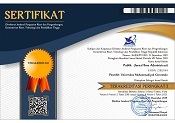Tourism Governance with Culinary Cognitive Images Base in the City of Pare-Pare
Abstract
Culinary tourism is a new thing in the repertoire of interesting and distinctive dishes and tourism. The food is in the form of food that is usually eaten and processed by local residents, and is not consumed outside the area. The purpose of this Reseach to know the tourism governance with culinary cognitive images based in the City of Pare-Pare. The population in this study is tourists Parepare City Destination. The sample was taken as many as 100 respondents from tourist Parepare City Destination. The analytical tool in this research is Descriptive Analysis, Instrument Test, Multiple Regression Analysis, Significance Test (t test), and Model Accuracy Test. The results showed that cognitive Culinary image has a significant positive effect on the interest of tourists visit Parepare City Destination, and affective Culinary image have a significant positive effect on the interest of tourist visit Parepare City Destination. Both variables are also influential together on the interest of tourists visit Parepare City Destination. Based on the result of this research, the management of Parepare City Destination can increase the interest of tourist visit by increasing the cognitive Culinary image variable and the affective Culinary image variable, because the increasing of both variables is increasing the tourist visit.
Keywords
Full Text:
PDFReferences
Baldwin, W. (2018). Chef's sabbatical: An analysis of chef's gastronomic research through culinary tourism. International Journal of Gastronomy and Food Science, 13, 65-72.
Batat, W. (2021). The role of luxury gastronomy in culinary tourism: An ethnographic study of Michelin‐Starred restaurants in France. International Journal of Tourism Research, 23(2), 150-163.
Destari, F. (2017). Meningkatkan intention to revisit melalui keunikan jasa pariwisata & destinasion aimage: Studi Kasus Pada Big Event JFC, Universitas Jember, 2017.
Dioko, L. D. A. (2017). The problem of rapid tourism growth–an overview of the strategic question. Worldwide Hospitality and Tourism Themes.
Dixit, S. K. (2019). Gastronomic tourism: a theoretical construct. In The Routledge handbook of gastronomic tourism (pp. 13-23). Routledge.
Ghozali, I. (2016). Aplikasi analisis multivariete dengan program ibm spss 23. Semarang: Universitas Diponegoro.
Hall, Colin Michael (2003), food tourism around the world: development,
Harianto, S. P., Walid Masruri, N., Winarno, G. D., Tsani, M. K., & Santoso, T. (2020). Development strategy for ecotourism management based on feasibility analysis of tourist attraction objects and perception of visitors and local communities. Biodiversitas Journal of Biological Diversity, 21(2), 689-698.
Hendarto, K.A. (2010). Model destination image dan tourist satisfaction: studi terhadap wisatawan asing di yogyakarta pasca gempa 27 mei 2006, (Universistas Hasanuddin, 2010).
Hendawan, G. (2015). Pengaruh citra destinasi pariwisata waduk sermo terhadap minat wisata berkunjung ulang. (Skripsi Universitas Sanata Darma Yogyakarta).
Holloway, L., & Kneafsey, M. (2017). Producing-consuming food: closeness, connectedness and rurality in four ‘alternative’food networks. In Geographies of rural cultures and societies (pp. 262-282). Routledge.
Priyatno, D. (2010). Teknik mudah dan cepat melakukan analisis data dan penelitian dengan spss da tanya jawab ujian pendadaran. Yogyakarta: Gava Media
Sayadabdi, A., & Hassibi, S. (2018). 10 Food and tourism in Iran. Tourism in Iran: Challenges, Development and Issues, 15.
Slocum, S. L., & Curtis, K. R. (2017). Food and agricultural tourism: Theory and best practice. Routledge.
Walter, P. (2017). Culinary tourism as living history: Staging, tourist
performance and perceptions of authenticity in a Thai cooking school. Journal of Heritage Tourism, 12(4), 365-379.
Article metrics
Refbacks
- There are currently no refbacks.
Copyright (c) 2021 Publik (Jurnal Ilmu Administrasi)

This work is licensed under a Creative Commons Attribution-ShareAlike 4.0 International License.

Publik (Jurnal Ilmu Administrasi) is licensed under a Creative Commons Attribution-ShareAlike 4.0 International License.










